When it comes to popular invertebrates, you can’t go wrong with saltwater shrimp.
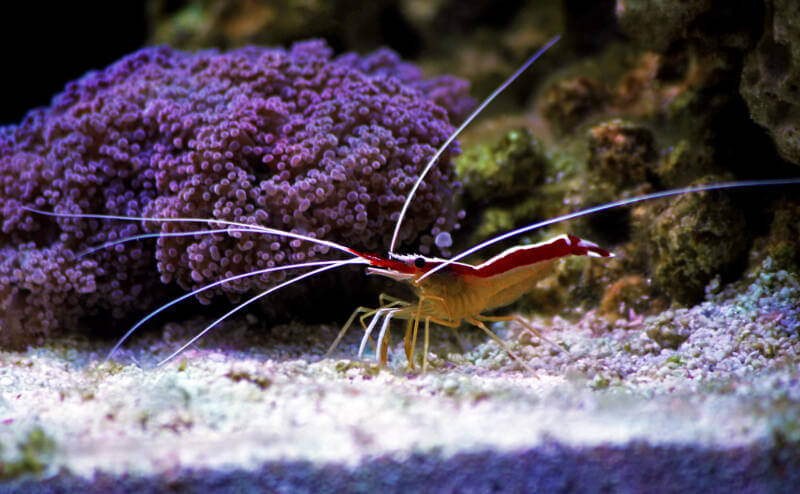
These little crustaceans span the spectrum in color – or they skip the color and opt for a transparent carapace, letting the natural beauty of your reef tank shine through.
Some saltwater shrimp form symbiotic relationships with animals on the reef.
They share living space to gain defense and hunting strategies. And they aid their corals, fish, or fellow invertebrates by removing nasty parasites.
Others venture out on their own, employing unique hunting strategies to track down their next meals. A few even pose a threat to YOU (so watch your fingers). It’s a spectrum that covers every invertebrate possibility.
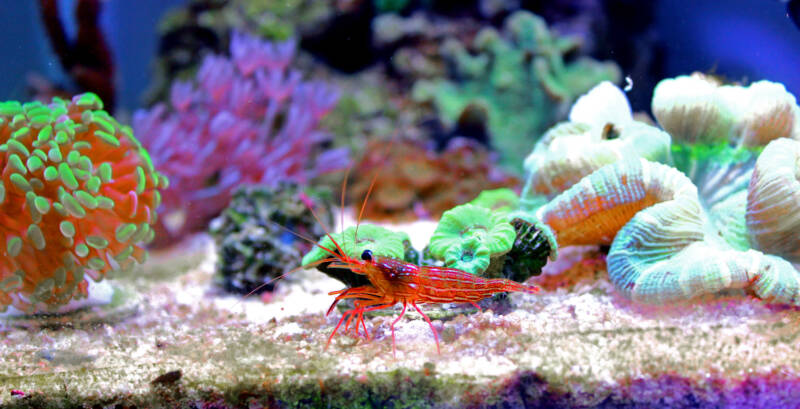
So if you’re looking for a new addition to your saltwater aquarium, consider one of these eighteen types of saltwater shrimp.
But make sure you read up on what you’re getting yourself into. Not every species works for every aquarist.
[toc]
18 Types of Saltwater Shrimp
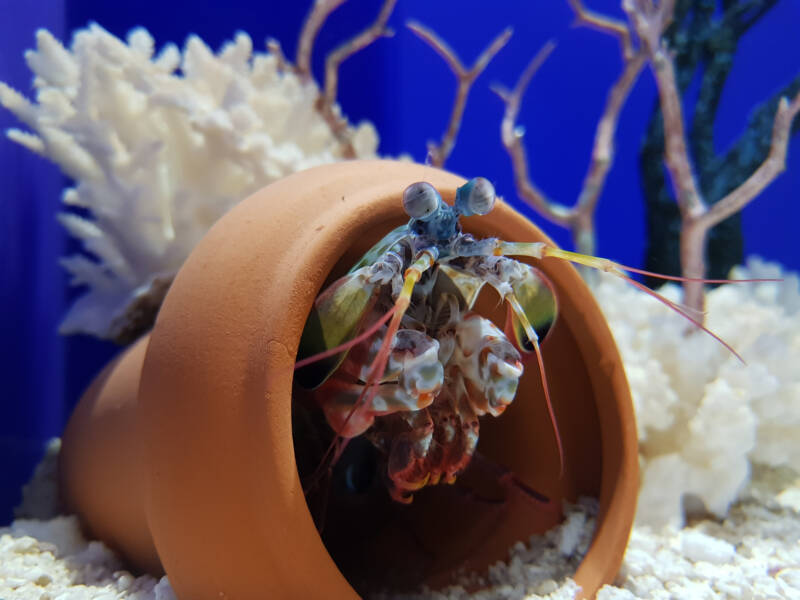
When you decide to add saltwater shrimp to your aquarium, you need to look at many variables.
How many can coexist together without squabbles breaking out? Will the species live peacefully on a reef? How expensive are the shrimps?
If you’ve managed saltwater and reef tanks for years, you have your pick of the shrimp spectrum.
But if this is your first foray into invertebrates, your choices are limited. Always perform your research carefully, making sure you have all the information you need.
These nineteen saltwater shrimp represent the tip of the iceberg. You’ll find some of the most common species aquarists prize.
And you’ll see one of the most beautiful saltwater shrimp in the ocean – which you’ll have to admire from afar (or on a scuba dive).
1. Blood Red Fire Shrimp (Lysmata debelius)
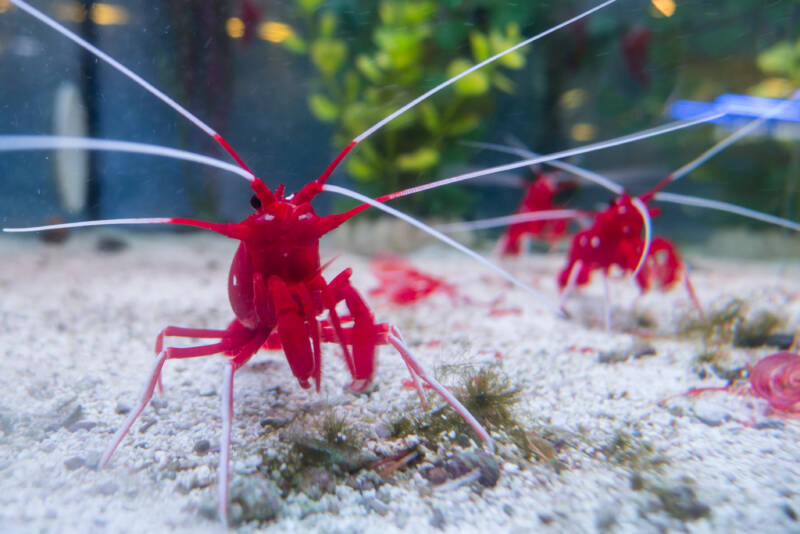
- In the Wild: Indonesia, Sri Lanka
- Length: Up to 3 inches (7.6 cm)
- Reef-Safe? With Precautions
- Difficulty: Easy
- Temperament: Peaceful
- Tank Size: 55 gallons (208 l)
- Diet: Carnivore
- Lifespan: 1-2 years
- Cost: $20-$ 35
Blood red fire shrimp come from the Lysmata genus of cleaner shrimp. As you can guess from their name, they have vibrant red color on their bodies. White dots break up the sides, and you’ll find white front legs and white antenna.
Fire shrimp prefer the nocturnal life, hanging upside down under ledges or in caves during the day.
They venture out at night and use their white antenna as a signal to fish that their cleaning operation is open for business.
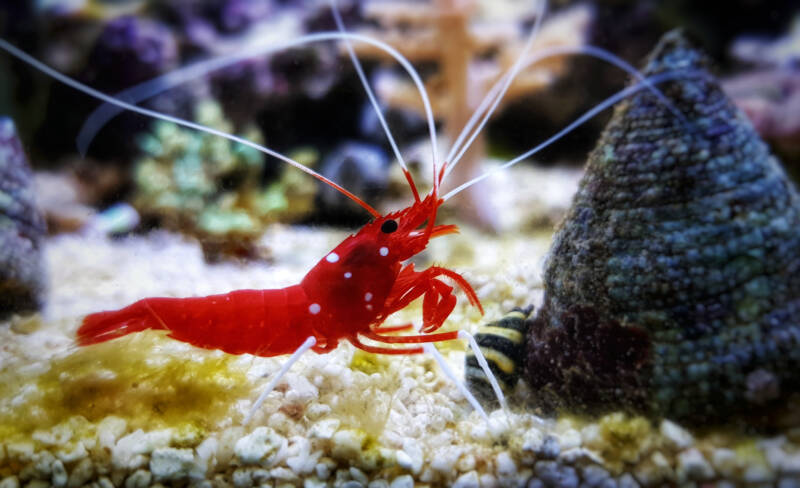
They remove parasites, dead tissue, and other skin irritants from the fish’s gills and scales.
Once fish catch on to the service, it doesn’t take long for “cleaning stations” to open up on rocks or coral outcroppings.
Fire shrimp do well on their own, though they will form mated pairs. You need to watch going into higher numbers as they’re VERY territorial. Watch any other shrimp in the tank, even with an aquarium of 55 gallons (208 l).
They have a habit of using their claws to pick at both LPS (large polyp stony) and SPS (soft polyp stony) corals.
You CAN add them to reef tanks, but keep an eye on them with your corals, just in case they get “snippy.”
2. Boxer Banded Shrimp/Banded Coral Shrimp (Stenopus hispidus)
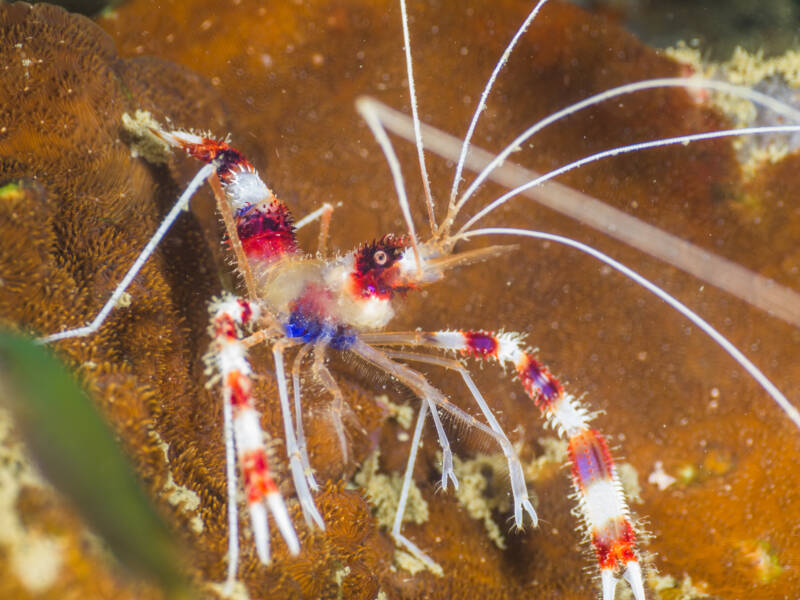
- In the Wild: Indonesia, Sri Lanka
- Length: 3 inches (7.6 cm)
- Reef-Safe? Yes
- Difficulty: Easy
- Temperament: Peaceful
- Tank Size: 20 gallons (76 l)
- Diet: Carnivore
- Lifespan: 2-3 years
- Cost: $10-$35
Boxer banded shrimp are also known as banded coral shrimp. The striking red and white patterns across their carapaces stand out in reef tanks, making them popular choices with aquarists of all levels.
Another nocturnal member of the saltwater shrimp group, they roam the tank after dark for uneaten food and meaty leftovers. If fish approach, they’ll oblige in cleaning. Unhappily, more aggressive members tend to attack sleeping fish.
Aquarists love banded shrimp for their unparalleled bristle worm hunting skills. These crustaceans make for natural pest control if you’re battling a bristle worm infestation. They track down every last one.
Unfortunately, banded shrimp have ZERO tolerance for one another. You’ll want to keep them on their own.
If you KNOW you have a mated pair, you can keep them together, but don’t go for a group. Banded Shrimp WILL fight to the death.
3. Bumblebee Shrimp (Gnathophyllum americanum)
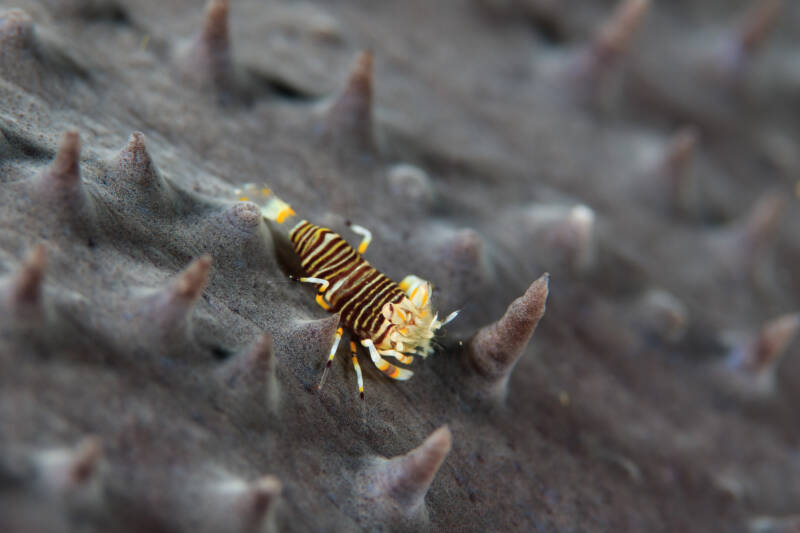
- In the Wild: Indo-Pacific
- Length: 1 inch (2.5 cm)
- Reef-Safe? Yes
- Difficulty: Moderate
- Temperament: Peaceful
- Tank Size: Nano Tanks
- Diet: Carnivore
- Lifespan: 18 months
- Cost: $10
As you might guess, bumblebee shrimp come in orange, yellow, black, and white striped patterns.
They’re also about the size of your average insectoid bumblebee. This makes them perfect for nano aquariums. (They get lost in larger tanks)
If you provide plenty of shelters, so your tiny bumblebees feel safe, you’ll see them venture out and move around during the day. Otherwise, they’ll stay out of sight until night falls and the activity in the tank settles down.
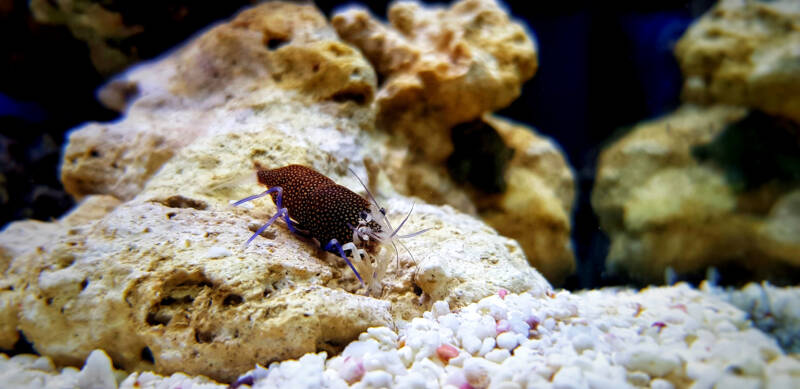
Bumblebee Shrimp feed on echinoderm tube feet. That’s right – they munch on the fleshy appendages of starfish and their relatives.
You can work on transferring them to thawed meaty foods (frozen meat won’t work), but they’d prefer echinoderm feet.
4. Coleman Shrimp (Periclimenes colemani)
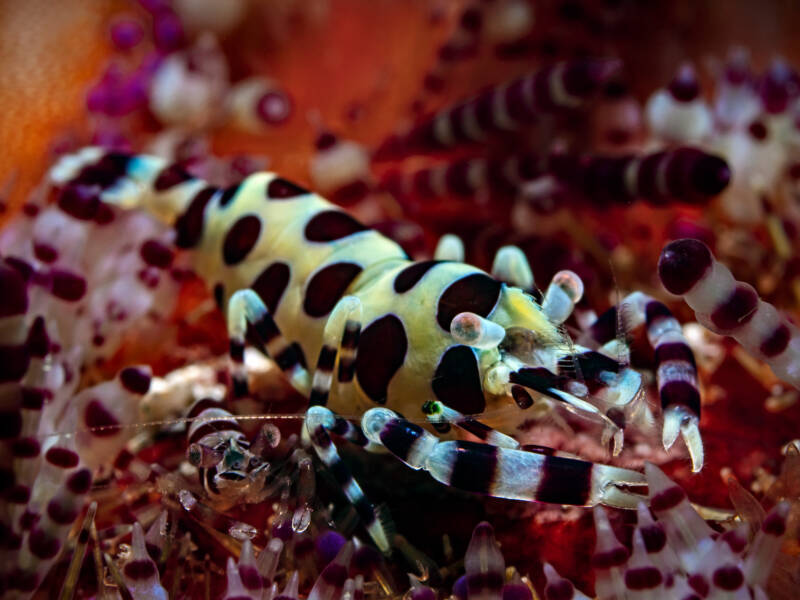
- In the Wild: Indo-Pacific
- Length: 0.75 inch (2 cm)
- Reef-Safe? Yes
- Difficulty: Impossible (Read below)
- Temperament: Peaceful
- Tank Size: Unknown
- Diet: Omnivore
- Lifespan: 1 year
- Cost: Unavailable
Catching a glimpse of a Coleman shrimp gets exceptionally tricky. While always found in pairs, these striped invertebrates start with impossibly tiny sizes.
Then they match their striped patterns to blend perfectly with their hosts: the fire urchin (Asthenosoma varium). In a perfect example of symbiosis, Coleman shrimp remove algae, plankton, and debris from their urchin’s test (the shell).
The fire urchin provides defense for the pair in the form of a venomous sting – NO ONE wants to encounter.
While gorgeous (scuba divers treasure pictures), don’t rush out to add these saltwater shrimp to your reef tank. Coleman shrimp are obligate symbionts. Without their trusty fire urchins, they don’t stand a chance of survival.
No one’s figured out how to collect Coleman shrimp. They’re too small.
Also, while everyone theorizes the crustaceans feed on the urchin test, no one’s observed the behavior. So jumping to the conclusion that you could import BOTH isn’t a guarantee.
For the time being, Coleman shrimp will remain a beautiful species that aquarists will admire – from afar.
Maybe someday will come when someone discovers more about their biology. And devise a way to ship them without stress. (It’s a dream)
5. Commensal Emperor Shrimp (Periclimenes imperator)
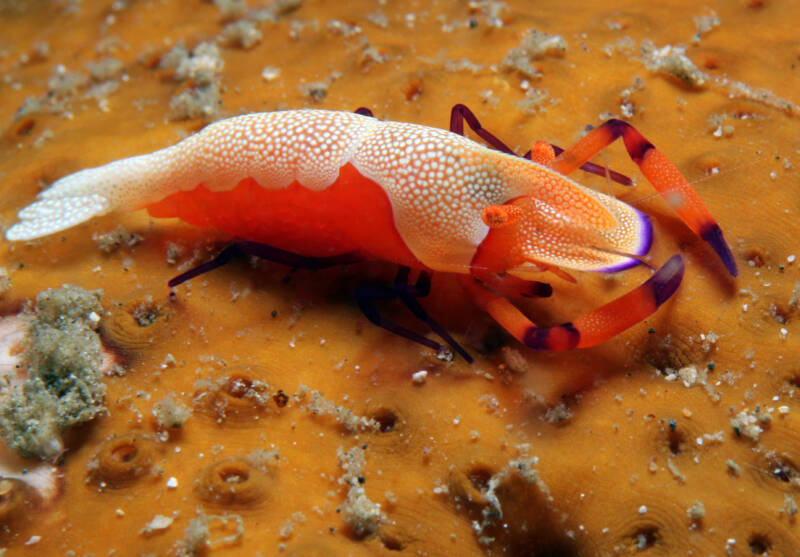
- In the Wild: Indo-Pacific
- Length: 1.2 inches (3 cm)
- Reef-Safe? Yes
- Difficulty: Difficult
- Temperament: Peaceful
- Tank Size: 2 Gallons (7.5 l) – Host-Dependent
- Diet: Carnivore
- Lifespan: Unknown
- Cost: $60-$100
Coming from the same genus as the Coleman shrimp, the commensal emperor shrimp isn’t much bigger.
They share the exact symbiotic nature, too. You find them on the back, abdomen, or gills of sea cucumbers and other nudibranchs.
Emperor shrimp come in a bright orange color along the sides, with a white and orange-spotted back.
Their orange claws feature purple tips, which they use to clean their hosts. They remove parasites, decaying organic matter, and any leftovers the sea cucumber might drop.
When you decide to add an emperor shrimp to your aquarium, the tank size is dependent on the host. You MUST add a sea slug or other nudibranch for the shrimp to “party up” with.
If the sea cucumber tolerates a 2-gallon (7.5 L) tank, then you’re set. If not, go up.
Emperor shrimp prefer to live on their own. When two end up on the same host, they’ll engage in a “turf war” to see who gets to stay. The battle usually takes place around the nudibranch’s mouth or anus.
6. Donald Duck Shrimp (Leander plumosus)
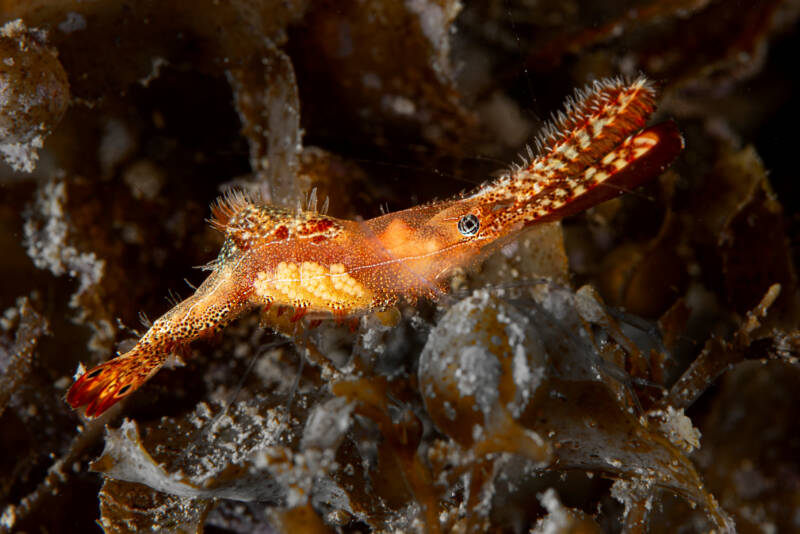
- In the Wild: Western Indo-Pacific
- Length: 1.5 inches (4 cm)
- Reef-Safe? Yes
- Difficulty: Moderate
- Temperament: Peaceful
- Tank Size: 30 Gallons (113 l)
- Diet: Omnivore
- Lifespan: Unknown (Short)
- Cost: $20
Yes, they named the Donald Duck shrimp for the flattened rostrum that gives it a prominent “duck beak.”
They also have a fuzzy camouflage appearance that allows them to disappear into their native reef environments (or your reef tank).
In the wild, Donald Duck shrimp hang out around beds of seagrass, sponges, coral beds, and rocky reefs. They’re not a common sight for divers, as their bizarre shape helps them hide within the background.
Donald Duck shrimp are relatively easy in the menu department. They scavenge on algae and zooplankton available in the tank.
They also appreciate sea worms and will accept the larvae of other species. (Yeah, don’t feel lousy offering up brine shrimp)
7. Durban Dancing Shrimp/Camel Shrimp (Rhynchocinetes durbanensis)
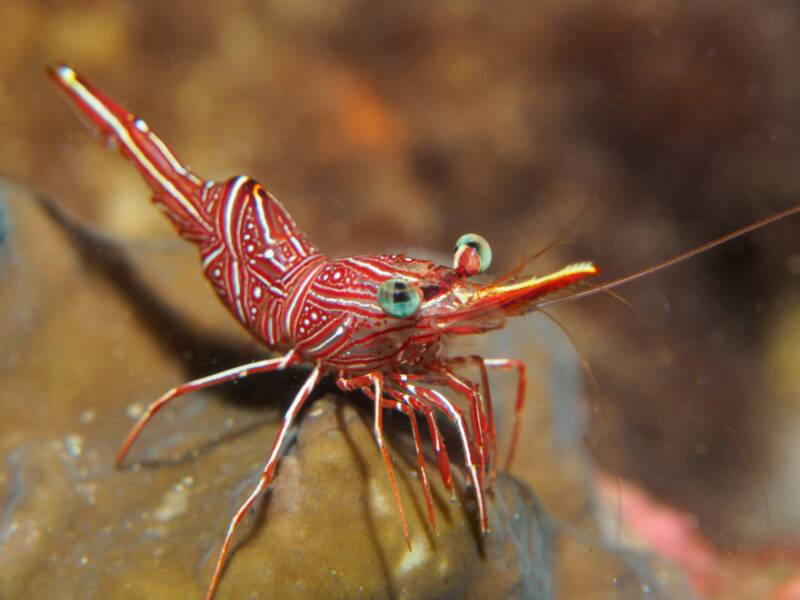
- In the Wild: Pacific
- Length: 2 inches (5 cm)
- Reef-Safe? With Precautions
- Difficulty: Easy
- Temperament: Peaceful
- Tank Size: 10 Gallons (38 l)
- Diet: Omnivore
- Lifespan: 3 Years
- Cost: $8-$10
Camel shrimp share a coloration pattern with peppermint shrimp. When you look at their backs, though, you’ll see a distinct hump (where they get their name). The white stripes are more prominent, as well, letting them stand out.
Camel shrimp prefer the nocturnal life, protecting their large eyes from bright lights.
When night falls, they venture out to sort through the debris that’s collected in the tank. They pick up any leftover food.

Unfortunately, some camel shrimp tend to snack on corals. If you keep them well-fed, they may leave your corals alone. Others feel compelled to pick.
Bubble coral and anemones may avoid harassment, but don’t count on it.
8. Glass Anemone Shrimp (Periclimenes brevicarpalis)
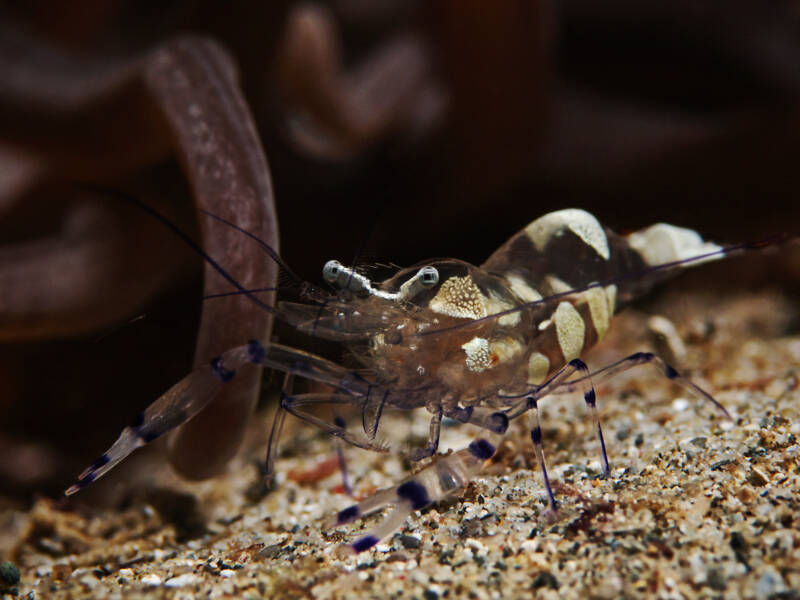
- In the Wild: Indo-Pacific
- Length: 0.8-1.2 inches (2-3 cm)
- Reef-Safe? Yes
- Difficulty: Easy
- Temperament: Peaceful
- Tank Size: 1 Gallon (4 l)
- Diet: Omnivore
- Lifespan: Uncertain
- Cost: $20-$35
You can find an assortment of names for the glass anemone shrimp: peacock-tail anemone shrimp, white-spot anemone shrimp, five-spot anemone shrimp, snow-capped anemone shrimp, and pontoniine shrimp. That’s a lot of names for a tiny crustacean!
The glass anemone’s carapace remains transparent with orange tints on the side and white dots along the back.
If you get closer, you can see purple tints on the legs. They’re beautiful to behold – when you can find them.
Glass anemone shrimp hang out with anemones (in case you didn’t figure that out).
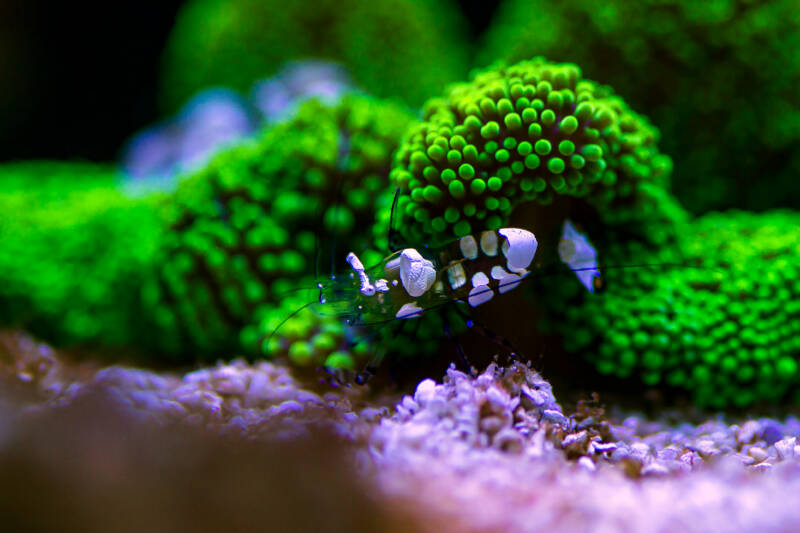
Pairs reside in a single anemone, clearing out parasites but also trimming away and eating tentacles. So while the shrimp gain defense, they’re not precisely benefiting their host.
You can keep a glass anemone shrimp in a 1-gallon tank without too much trouble. However, they’re happiest with an anemone. With their unique beauty, it’s worth scaling up so you can include both in your aquarium.
9. Harlequin Shrimp (Hymenocera picta)
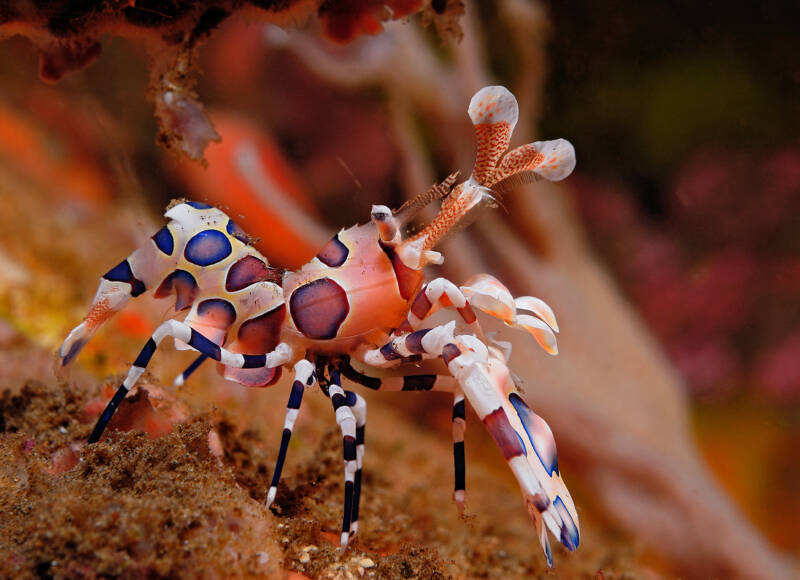
- In the Wild: Africa, Indian Ocean
- Length: 1.5-2 inches (3.8-5cm)
- Reef-Safe? Yes
- Difficulty: Moderate
- Temperament: Peaceful
- Tank Size: 10 Gallons (38 l)
- Diet: Carnivore
- Lifespan: 7 years
- Cost: $30-$50
Harlequin shrimp are one of the most beautifully patterned marine shrimp you’ll find. Their swirling blue, white, and tan colors make stunning additions to reef tanks.
And since they have no problem scuttling around during the day, you’ll love having them around.
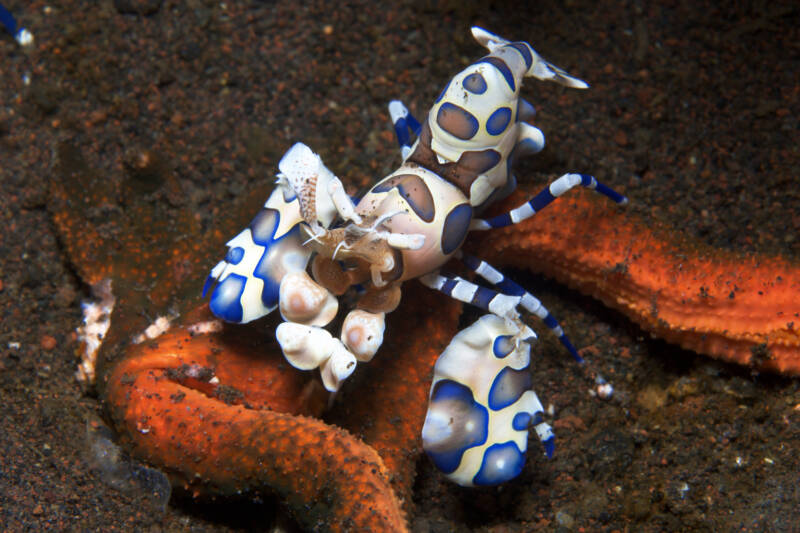
Unfortunately, harlequin shrimp have complicated menus to accommodate. They want starfish and ONLY starfish. (Okay, you can throw an occasional sea urchin in there)
You’ll need to decide if this specialized diet is worth the trouble.
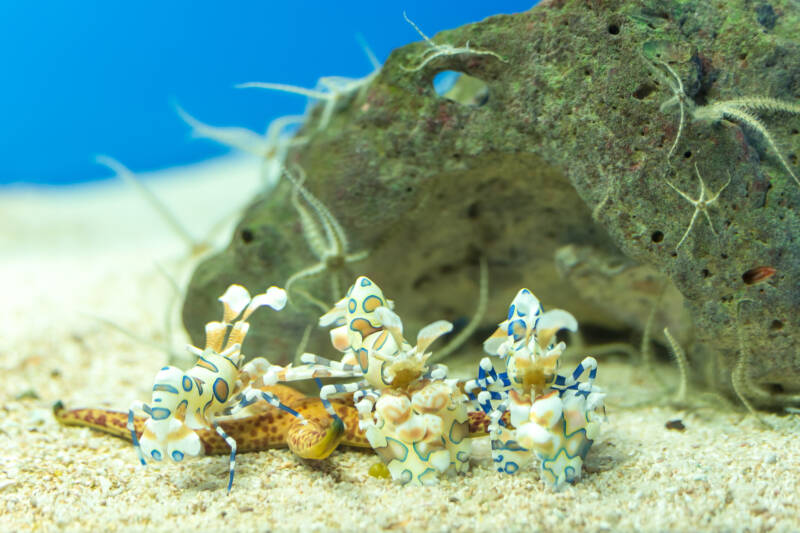
Harlequin shrimp do well in mated pairs. They work together to hunt their targeted starfish. They flip the echinoderm over to expose the vulnerable underside. Then they drag it away to their lair to feed in peace.
Females are larger than males. And while they sound brutal in their meal choices, they have shy temperaments.
You’ll want to make sure you provide live rocks and plenty of coral hiding places. However, other than starfish, they’ll leave everyone else in the tank alone.
10. Mantis Shrimp (Odontodactylus scyllarus)

- In the Wild: Africa, Indian Ocean
- Length: Up to 8 inches (20 cm)
- Reef-Safe? No
- Difficulty: Moderate-Difficult
- Temperament: Aggressive
- Tank Size: 25 Gallons (94 l)
- Diet: Carnivore
- Lifespan: 3-6 years
- Cost: $50-$100
Surprise! Mantis shrimp aren’t shrimp! They belong to the crustacean group known as Stomatopods. However, they look similar to shrimp, so people often include them in the saltwater shrimp group.
Mantis shrimp come in two different types. “Spearers” evolved one claw into a razor-sharp instrument they use to stab their prey. “Smashers” evolved their claws into identical clubs to crack open mollusks.
The most striking member of the mantis shrimp group is the peacock mantis. They’re monsters, reaching up to 8 inches (20 cm) in length. But they come in beautiful shades of red, green, and blue.
Large eyes help them pinpoint their prey and bring down their clubs.
Mantis shrimp should NEVER accompany ANY other fish in a reef tank! Before you know it, they’ll maim or eat everything in the aquarium.
And if you don’t watch what you’re doing, they’ll smack YOUR hand. Mantis Shrimp are famous for their aggression.
11. Marbled Shrimp (Saron marmoratus)
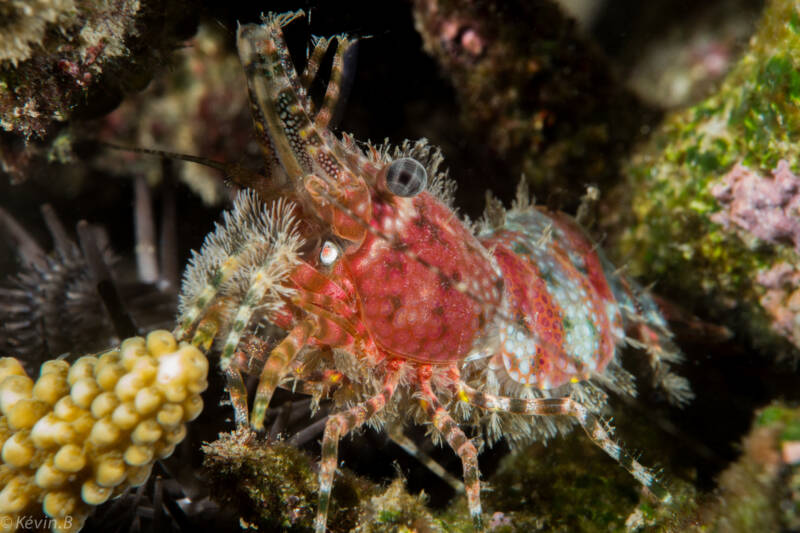
- In the Wild: Hawaii, Indonesia, Maldives
- Length: 2 inches (5 cm)
- Reef-Safe? No
- Difficulty: Easy
- Temperament: Peaceful
- Tank Size: 2-5 Gallons (7-19 l)
- Diet: Omnivore
- Lifespan: Up to 3 Years
- Cost: $5-$10
Marbled shrimp make separating males and females easy – something you don’t always find in marine shrimp.
Females have bristles along their front legs, but males don’t. It’s a simple way to check which you’re getting at the pet store. Nocturnal in nature, marbled shrimp participate in tank clean-up duty.
They have shy temperaments, so they hide out during the day, where they have green or tan colorations. As the lights go down, they turn red.
Marbled shrimp eat just about anything they come across. They’ll seek out leftover fish food, algae, or debris. And, unhappily, they’ll help themselves to your coral polyps.
You want to skip adding these saltwater shrimp to reef tanks if you’re going to keep your corals safe.
12. Pederson’s Shrimp (Ancylomenes pedersoni)
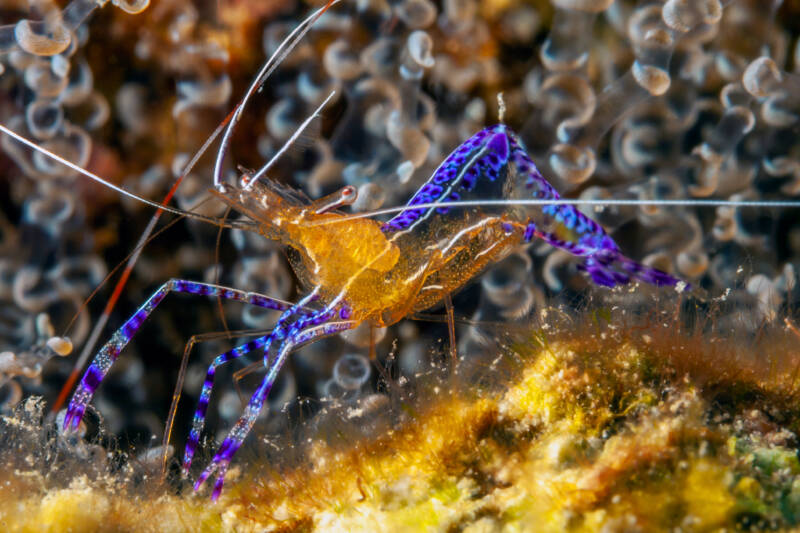
- In the Wild: Caribbean
- Length: 1-1.5 inches (2.5-4 cm)
- Reef-Safe? Yes
- Difficulty: Easy
- Temperament: Peaceful
- Tank Size: 5 Gallons (19 l)
- Diet: Omnivore
- Lifespan: 1.5 Years
- Cost: $20-$30
Pederson’s shrimp is another member of the cleaner family. They use their white antennae for advertising the cleaning business, poking their heads out of anemone tentacles.
They share a symbiotic relationship with the anemone. Unlike some saltwater shrimp, you’ll come across, Pederson’s have no problem living and working together.
They prefer to stay in groups of at least three. They have a social dynamic, and the more you accommodate, the better.
Pederson’s shrimp live within anemones in their native Caribbean waters, but you DON’T need to worry about adding an anemone to your tank.
They’ll happily live within an aquarium without one – just make sure they have hiding places.
13. Peppermint Shrimp (Lysmata wurdemanni)
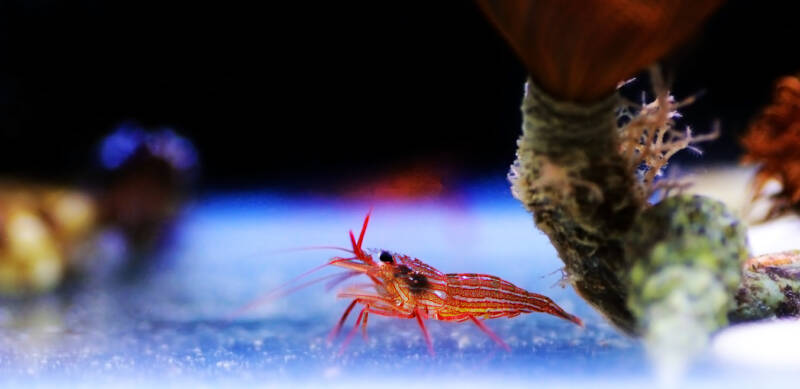
- In the Wild: Caribbean
- Length: 1.5 inches (3.8 cm)
- Reef-Safe? With Precautions
- Difficulty: Easy
- Temperament: Peaceful
- Tank Size: 10 Gallons (38 l)
- Diet: Carnivore
- Lifespan: 2 Years
- Cost: $5-$10
Peppermint shrimp come in red or pink with darker stripes down their bodies. They’re on the small side, and they often disappear into reef tanks.
If you want a more visible and prominent saltwater shrimp, they may not be your first choice.
Aquarists love peppermint shrimp for another reason. These little invertebrates LOVE Aiptasia.
This pest of saltwater aquariums reproduce at an insane rate, but peppermint shrimp savor them like popcorn. They’ll happily hunt them down and eradicate them.
Peppermint shrimp tolerate staying on their own, in pairs, or even in groups, giving you plenty of flexibility. They participate in some cleaning behavior, but it’s not consistent. You may want to look for other shrimp for better reliability.
You also need to keep an eye on your reef tank. They WILL go after polyps. After all, they have no problem devouring Aiptasia.
If you don’t want your peppermint shrimp to devastate your growing corals, avoid mixing the two.
14. Rockpool Shrimp/Common Prawn (Palaemon elegans)
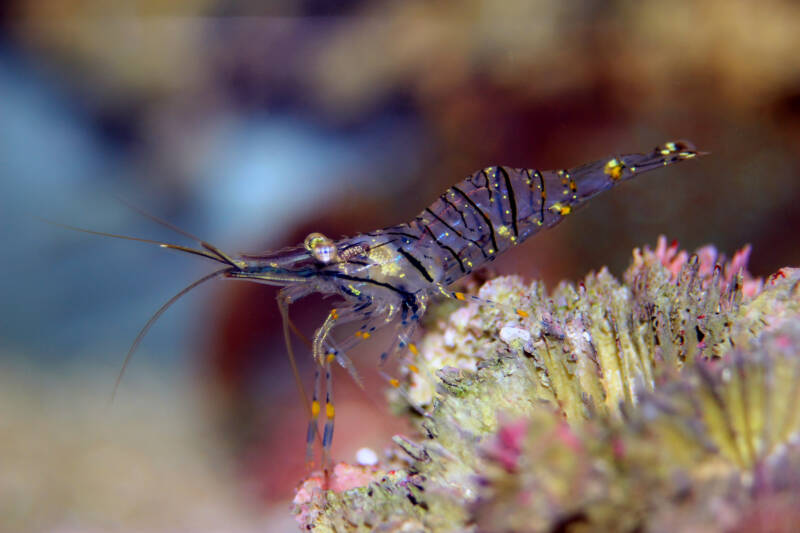
- In the Wild: Atlantic from Norway to Africa, Mediterranean
- Length: 0.5-1.5 inches (1-3.8cm)
- Reef-Safe? Yes
- Difficulty: Easy
- Temperament: Peaceful
- Tank Size: 10 Gallons (38 l)
- Diet: Omnivore
- Lifespan: 3 months
- Cost: Unknown
Rockpool shrimp are an interesting case. Also known as the common prawn, these are the saltwater shrimp you often find when you wade into tidepools on vacation.
Most regions consider them food sources – when they aren’t nuisances. Aquarists like their transparent carapaces with brown and black patterns.
The adaptive coloration allows them to hide out in seagrass beds, protecting them from predators.
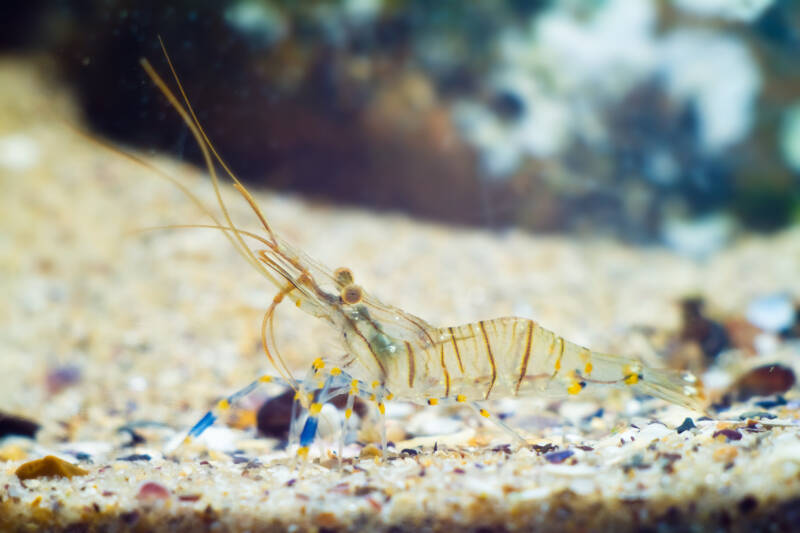
It turns out, A LOT of animals consider them a delicious part of the menu.
15. Sea Star Shrimp/Starfish Shrimp (Periclimenes soror)
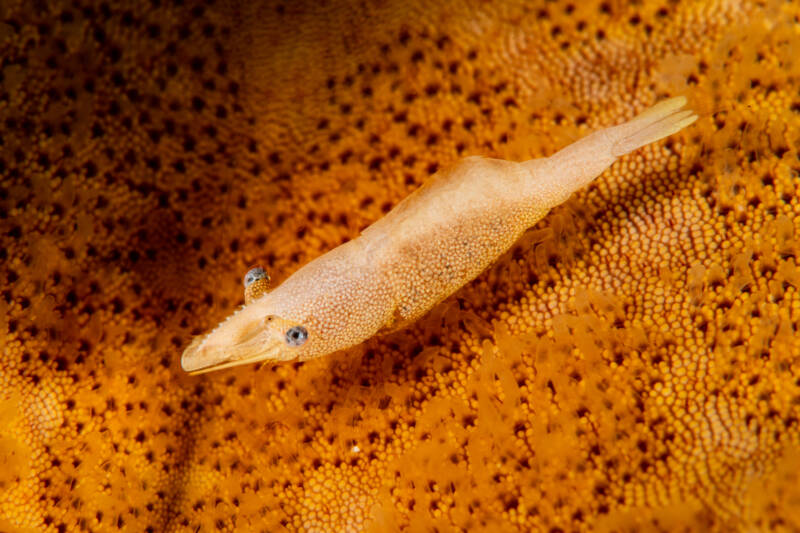
- In the Wild: Indo-Pacific
- Length: 0.5 inches (1.5cm)
- Reef-Safe? Yes
- Difficulty: Difficult
- Temperament: Peaceful
- Tank Size: Unknown
- Diet: Omnivore
- Lifespan: 5 Years
- Cost: Unknown
Starfish shrimp take their name from their symbiotic relationship. These tiny saltwater shrimp take up residence on the backs of starfish.
Specifically, they prefer the company of species in the Linckia, Acanthaster, Culcita, and Choriaster genera.
While the starfish provides protection, the starfish shrimp removes parasites, algae, and plankton from the surface and around their obliging host.
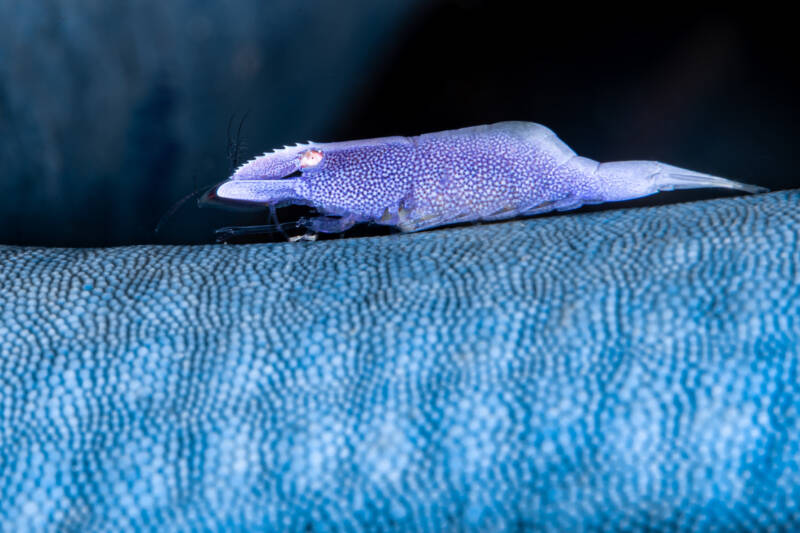
It’s a comforting balance. And since starfish roam around the reef, the crustacean gets to travel everywhere.
You’ll see anywhere from one to TWENTY-FOUR starfish shrimp on a single echinoderm. It depends on the size of the host.
Unhappily, unless your tank can support the starfish, you’re not likely to bring this marine shrimp home.
16. Skunk Cleaner Shrimp/Red Line Cleaner Shrimp (Lysmata amboinensis)

- In the Wild: Africa, Indonesia, Sri Lanka
- Length: 2 inches (5 cm)
- Reef-Safe? Yes
- Difficulty: Easy
- Temperament: Peaceful
- Tank Size: 30 Gallons (113 l)
- Diet: Omnivore
- Lifespan: Up to 3 Years
- Cost: $20-$30
Skunk cleaner shrimp sport a prominent white stripe down their backs, as you might guess from their name.
They also have a vibrant red color to set it off. And, as with other cleaner shrimp, the white antennae signal fish in the tank.
Skunk cleaners have a bold streak when it comes to cleaning. As they adapt to the fish in your aquarium, they’ll venture into their MOUTHS. This way, they reach the gill arches and between teeth, pulling out leftover food morsels.
You can keep a skunk cleaner shrimp on its own, but they’ll hide all the time. You’re better off keeping at least three.
They’ll patrol the tank, picking up algae, leftover bits of commercial food, and those pesky skin parasites.
17. Snapping Shrimp/Pistol Shrimp (Alpheus spp.)
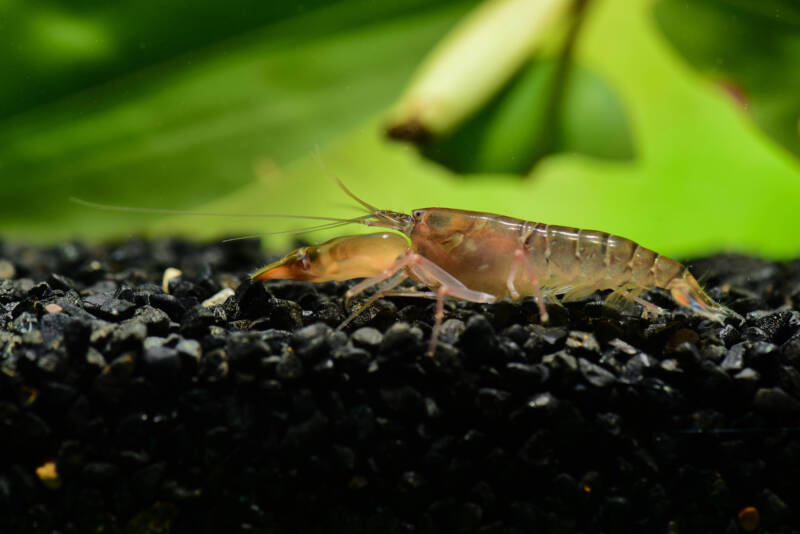
- In the Wild: Worldwide
- Length: 1-3 inches (2.5-7.6 cm)
- Reef-Safe? Yes
- Difficulty: Easy-Moderate
- Temperament: Peaceful
- Tank Size: 30 Gallons (113 l)
- Diet: Carnivore
- Lifespan: 4 Years
- Cost: $20-$ 40
Snapping shrimp take their name from an adaptation in their claw.
A cavitation bubble allows them to shoot a “bullet” of water at prey or potential predators. The target gets stunned, and it’s even possible to see a brief flash of light when the bubble collapses.
Pistol shrimp are one of the most popular snapping shrimp species, and they form a symbiotic relationship with gobies.
The goby provides a sharper vision for the crustacean and shares its burrow. The pair may even share food stores.
If you want to include a pistol shrimp, consider purchasing it WITH its paired goby. They need an established relationship to settle in. Pet stores often sell this combination, letting you introduce the two into your tank at one time.
You can often hear your snapping shrimp – even if you can’t see them. Males battle for the territory within an aquarium, using their distinctive claws in the process.
Many aquarists report hearing the pops of sound. They even record it in the ocean!
18. Spiny Tiger Shrimp (Phyllognathia ceratophthalma)
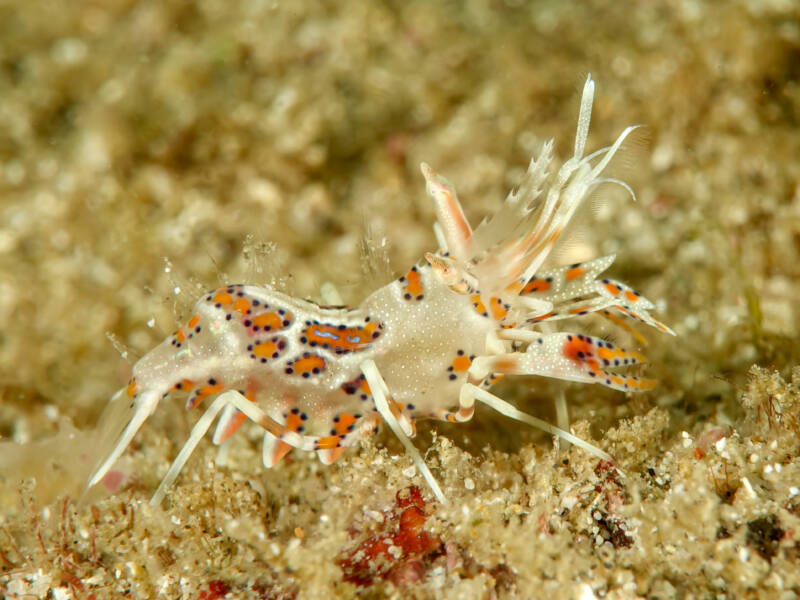
- In the Wild: Indonesia, Philippines
- Length: 0.2 inch (1.3 cm)
- Reef-Safe? Yes
- Difficulty: Difficult
- Temperament: Semi-Aggressive
- Tank Size: 10 Gallons (38 l)
- Diet: Carnivore
- Lifespan: 4 Years
- Cost: $100
The spiny tiger shrimp also shows up under the names horned bumblebee shrimp or bongo shrimp.
They have prominent orange stripes on their legs, which is where the names come from. And while popular additions to aquariums, they’re relatively rare.
As spiny tiger shrimp grow, the spines get more impressive. You’ll also see slight variations in their color depending on the region where they’re collected. It’s a pretty narrow area, though – they stay in the Coral Triangle.
Spiny tiger shrimp feed on sea stars and brittle stars. This makes caring for them a little tricky.
They use the sharp tip of their claws to repeatedly jab into the echinoderm until it collapses. (Talk about not judging a book by its cover!)
19. Sexy Shrimp (Thor amboinensis)

- In the Wild: Global
- Length: 1.25 inches (3 cm)
- Reef-Safe? Yes
- Difficulty: Easy
- Temperament: Peaceful
- Tank Size: 5 Gallons (19 l)
- Diet: Carnivore
- Lifespan: 3 Years
- Cost: $25-$30
Found throughout the tropical waters of the world, sexy shrimp – or dancing shrimp, pikmin shrimp, or high-tailed shrimp, as they’re also called – delight sharp-eyed divers and aquarists alike.
These symbiotic shrimp partner up with TWELVE different species of anemones.
Due to their small size, people often overlook sexy shrimp.
This is a shame because they partake in spectacular “dances” where they lift their abdomens and wave them back and forth.
And the more shrimp you have in a group? The better the dancing gets. (They’re highly social)
Paired up with their chosen anemone, these shrimp gain protection, and defense.
In return, they remove unwanted slime coats and parasites from the anemone’s tentacles.
They’re seconded by only clownfish when it comes to sharing space with sea anemones.
Tank Setup for Saltwater Shrimp
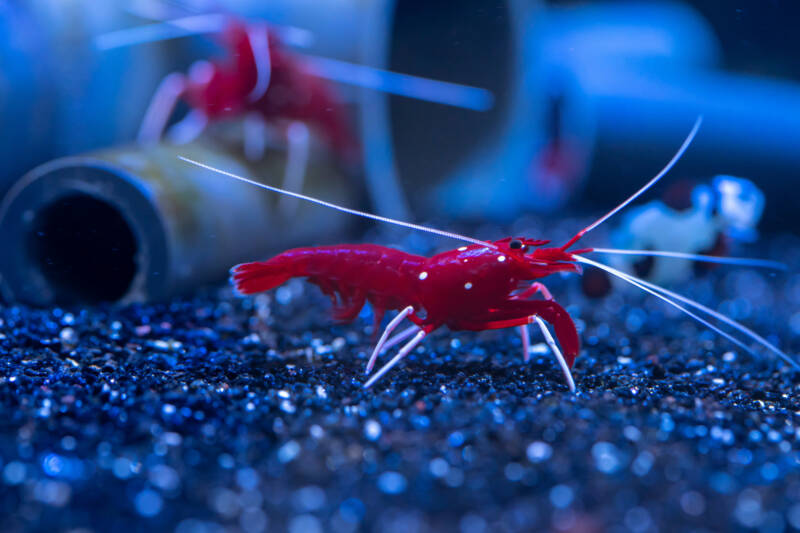
If every saltwater shrimp needed the same tank conditions…well, life would be easy. As the species come from every region around the globe, you’ll have to do some research. You want to maintain optimum health.
In general, this group of crustaceans avoids the parasites and diseases that take down reef fish.
However, that doesn’t let you off the hook from providing a clean, healthy tank system. You need a cycled tank before you add saltwater shrimp to the mix.
Saltwater shrimp also demand high oxygen content in their waters. If you don’t have a protein skimmer in your reef tank, consider adding one.
You may also need to consider the stock within your aquarium. Are the shrimp overdoing it? Look at things carefully.
Saltwater Shrimp Communities
Saltwater shrimp come in every size, from tiny to massive. And not all of these crustaceans come prepared to defend themselves. You want to add a new dimension to your reef tank, but you need to think carefully about the community dynamic.
Aquarists like adding saltwater shrimp to their reef tanks for the clean-up benefits.
Most of the group have scavenger tendencies, so they hang out at the bottom and cruise the substrate. But you need to consider tank mates carefully.
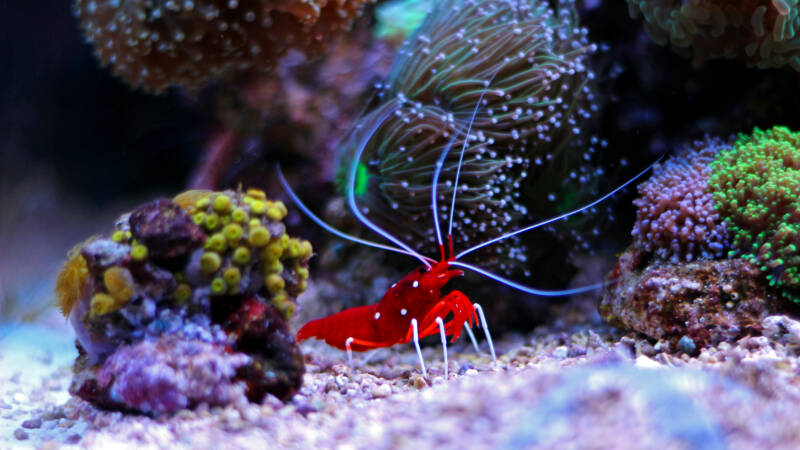
Compatible Reef Fish Species
Focus on reef fish that won’t bother your shrimp. You’ll end up with a gorgeous aquarium, but the group will remain peaceful. The best options to keep everyone safe include:
- Angelfish
- Blennies
- Butterflyfish
- Damselfish
- Dragonets
- Rabbitfish
- Surgeonfish
- Wrasses.
Incompatible Reef Fish Species
Every saltwater shrimp species is different. Most fall into a size category that won’t hassle your fish. But the other end of the spectrum?
That’s where you get into trouble. Many marine fish love a bite of shrimp. And the bigger the fish, the bigger the problem.
As beautiful as they appear in a reef setting, the following fish pose threats to marine shrimp. Avoid them if you have your heart set on crustaceans:
- Cardinalfish
- Comets
- Coral catfish
- Dottybacks
- Groupers
- Goatfish
- Hawkfish
- Lizardfish
- Morays
- Puffers
- Pseudochromoids
- Rays
- Sharks
- Snappers
- Squirrelfish
- Tilefish
- Toadfish
- Triggerfish.
Saltwater Shrimp Diets
Aquarists love saltwater shrimp for their cleaning habits. Most species feed on pests and debris in a tank.
As they sift through the substrate, they bring old sand to the surface, improving circulation and aiding you in the cleaning process.
The majority of marine shrimp fall into the omnivore category. They’ll eat anything they find (including fish small enough to get between their claws).
As long as high-quality foods reach the bottom of the tank, they’ll remain healthy and happy.
You can provide everything from live foods, processed tablets and pellets (look for sinking varieties), and frozen foods.
But DON’T rely on what these crustaceans scavenge from the tank. They can’t scrape up enough pests, algae, and debris to prevent starvation.
However, there are specialized saltwater shrimp. They require specific elements in their diet to remain healthy.
Fail to provide the proper food, and your shrimp perish. For instance, Harlequin Shrimp ONLY eat sea stars. You’ll need a supply to keep them happy.
Varied Crustaceans
No matter what color, pattern, or lifestyle you’re interested in, there’s a saltwater shrimp to match.
You may need to brush up your skills to bring some of the species home, though. And some of the most beautiful remains an unachievable dream.
But these charming invertebrates are the perfect additions to many reef tanks.
They help keep your fish free of parasites, remove leftover food, and add a touch of whimsy. They’re the finishing touch to a well-cycled saltwater tank.
Do you have marine shrimp? Have you braved a mantis shrimp?
Which of the tiniest shrimp species do you find the most enchanting?
Let us know your questions and stories here!
